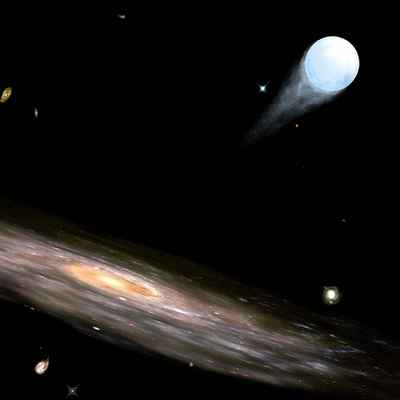Astronomers using the MMT observatory in Arizona discovered two exoplanets escaping the Milky Way. These stars run out of the galaxy at a speed of over 1.6 million km/h, so fast that they will not return.

Astronomers using the MMT observatory in Arizona discovered two exoplanets escaping the Milky Way. These stars run out of the galaxy at a speed of over 1.6 million km/h, so fast that they will not return.
These stars are literally survivors of a shipwreck, says astronomer Warren Brown of the Howard Smithsonian Center for Physics. "They were thrown out of their home galaxy and started sailing the ocean of intergalactic space." said.
Brown and his colleagues are expected in Gola Galactic for the first time in 2005. A European group identified two more - one of which originated in the neighboring galaxy "the Large Magellanic Cloud". The latest discovery brings the total number of exiled stars to five.
"These stars form a new type of astronomical objects - exoplanets leaving the galaxy." Brown said.
Astronomers estimate that there are at least a thousand alien stars in our galaxy, out of the 100 billion stars in it, and therefore locating such stars is like looking for a needle in a haystack. Smithsonian team members improved their chances by preselecting stars with locations and characteristics of typical exoplanets. They examined dozens of candidates scattered over an area of the sky 8,000 times larger than the full moon to locate what they were looking for.
"The discovery of the two outliers was not random and was not a matter of luck," said Margaret Geller of the Smithsonian Astrophysical Observatory, a co-author of the paper. "We conducted a targeted search for them. By understanding their origin we can locate them." saying.
The theory predicts that there are stars that were thrown from the center of the galaxy millions of years ago. Each star was once part of a double (binary) star system. When a binary system gets too close to the black hole at the center of the galaxy, the increased gravity can pull the two apart, trapping one of the stars and violently ejecting the other at enormous speeds, hence their technical name - hypervelocity stars.
The two stars that were discovered are short-lived stars that are only 4 times that of the Sun. There are many stars of their kind in the center of the galaxy, and hence the finding supports the theory as to their origin. Moreover, detailed studies of the galactic center have revealed stars orbiting the black hole in extremely elongated elliptical orbits—the kind of orbit expected from being former companions of a hyperfast star.
"Computer models show how these hyperfast stars form naturally near the center of the galaxy," says theorist Avi Leib of the Harvard-Smithsonian Center for Astrophysics. "We know that at the center of the galaxy resides a supermassive black hole, so it is almost certain that goliaths will be produced when a pair of stars passes too close to the black hole.
Astronomers estimate that a star is thrown from the center of the galaxy once every 100 years on average. The chances of seeing the ejected star now are slim. Hunters must therefore continue to find examples of exoplanets to understand the extreme environment that exists at the center of the galaxy and how this extreme environment leads to the formation of hyperfast stars.
